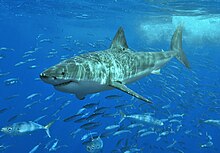
Back Elasmobranchii Afrikaans صفيحية الخياشيم الغضروفية Arabic صفيحية الخياشيم الغضروفيه ARZ Elasmobranchii AST Yastıqəlsəməlilər Azerbaijani Пласцінашчэлепныя Byelorussian Пластинчатохрили Bulgarian Elasmobranquis Catalan Pagig-iho CEB Příčnoústí Czech
| Elasmobranchii Temporal range:
| |
|---|---|

| |
| Great white shark (Carcharodon carcharias) | |
| Scientific classification | |
| Domain: | Eukaryota |
| Kingdom: | Animalia |
| Phylum: | Chordata |
| Class: | Chondrichthyes |
| Subclass: | Elasmobranchii Bonaparte, 1838 |
| Superorders | |


From a practical point of view the life-history pattern of elasmobranchs makes this group of animals extremely susceptible to over fishing. It is no coincidence that the commercially exploited marine turtles and baleen whales, which have life-history patterns similar to the sharks, are also in trouble.
Elasmobranchii is a subclass of the Chondrichthyes or cartilaginous fish. It includes the modern sharks and the rays and skates.
- ↑ Märss, Tiiu; Gagnier, Pierre-Yves (2001). "A new chondrichthyan from the Wenlock, Lower Silurian, of Baillie-Hamilton Island, the Canadian Arctic". Journal of Vertebrate Paleontology. 21 (4): 693–701. doi:10.1671/0272-4634(2001)021[0693:ANCFTW]2.0.CO;2. S2CID 86329421.
- ↑ Fowler, S.L. (2005). "Cetorhinus maximus". IUCN Red List of Threatened Species. 2005: e.T4292A10763893. doi:10.2305/IUCN.UK.2005.RLTS.T4292A10763893.en.
- ↑ "Galeorhinus galeus (School shark)". IUCN Red List of Threatened Species. 2005-06-17. 2005-06-17. Retrieved 2013-03-26.[permanent dead link]
- ↑ Guallart; et al. (2006). "Centrophorus granulosus". IUCN Red List of Threatened Species. 2006. Retrieved 11 May 2006.
- ↑ Benton, Michael J. (2015). Vertebrate Palaeontology (3rd ed.). Blackwell. p. 185. ISBN 9781118406847. OCLC 945675149.